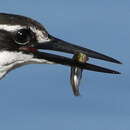mk
имиња во трошки


Die Rivierrondeharing (Gilchristella aestuaria) is 'n vis wat endemies is aan Suid-Afrika en kom voor vanaf die Olifantsrivier tot by die suide van Mosambiek. In Engels staan die vis bekend as die Estuarine roundherring.
Die lyf is ietwat plat. Die vis is deurskynend blou met 'n ligte streep langs die sye. Dit het 'n silwer kop en die onderste gedeelte van die liggaam is ook silwer. Daar is ook swart kolletjies aan die rugkant en kop van die vis. Die vis word slegs 7 cm groot
Die vis kom voor in riviermondings, kusbaaie en mere en bly in skole saam en word selde in die see gevind. Hulle vreet soöplankton deur of filter-voeding of deur die prooi een-een te jag.
Die Rivierrondeharing (Gilchristella aestuaria) is 'n vis wat endemies is aan Suid-Afrika en kom voor vanaf die Olifantsrivier tot by die suide van Mosambiek. In Engels staan die vis bekend as die Estuarine roundherring.
Gilchristella aestuaria és una espècie de peix pertanyent a la família dels clupèids i l'única del gènere Gilchristella.[4]
Té lloc al llarg de tot l'any amb un pic a la primavera i inicis de l'estiu.[5]
Menja principalment zooplàncton.[7]
A Sud-àfrica és depredat per Galeichthys feliceps, Elops machnata, Thryssa vitrirostris, Pomatomus saltatrix, Argyrosomus holepidotus, Argyrosomus hololepidotus, Lichia amia, Monodactylus falciformis, Platycephalus indicus, Ceryle rudis i Hydroprogne tschegrava.[8]
És un peix d'aigua dolça, salabrosa i marina; pelàgic-nerític; amfídrom i de clima subtropical (25°S-36°S, 17°E-34°E).[5][9][10]
Es troba a Àfrica: Moçambic, Sud-àfrica, Swazilàndia i Tanzània.[11][12][13][13][14][15][6][16][17][18][19][20][21][22]
Pot assolir els 6 anys d'edat.[23]
Es comercialitza fresc o en salaó.[24]
És inofensiu per als humans.[5]
Gilchristella aestuaria és una espècie de peix pertanyent a la família dels clupèids i l'única del gènere Gilchristella.
Gilchristella aestuaria, the Gilchrist's round herring or estuarine round-herring,[2] is a member of the herring family Clupeidae that occurs off the coasts of Southern Africa. It is the only species in its genus, which was named for John Dow Fisher Gilchrist (1866–1926).[3]
There are no indications of major threats to this species. It is considered to be of least concern for becoming an endangered species.[1]
The average length of the G. aestuaria as an unsexed male is about ten centimeters.[4]
The Gilchristella aestuaria can be found in a marine environment and in freshwater. The habitat is located in subtropical climates. This species is primarily found in estuaries, lagoons, lakes, and rivers.[4] It is considered an extremely important fish in estuaries of South Africa .[5] This small sardine-like fish lives in large shoals and provides an important link in the food chain as a food source to larger fish and water birds.[5] This fish does not survive in an aquarium, presumably dying from capture myopathy or stress.[5]
The Gilchristella aestuaria is distributed throughout the following areas:
Gilchristella aestuaria, the Gilchrist's round herring or estuarine round-herring, is a member of the herring family Clupeidae that occurs off the coasts of Southern Africa. It is the only species in its genus, which was named for John Dow Fisher Gilchrist (1866–1926).
Gilchristella aestuaria Gilchristella generoko animalia da. Arrainen barruko Clupeidae familian sailkatzen da.
Gilchristella aestuaria Gilchristella generoko animalia da. Arrainen barruko Clupeidae familian sailkatzen da.
Gilchristella aestuaria est une espèce de poissons de la famille Clupeidae présente au large des côtes d'Afrique australe. C'est la seule espèce du genre Gilchristella qui a été nommé en hommage à l'ichtyologiste sud-africain John Dow Fisher Gilchrist (1866-1926)[3]. Ce poisson abondant en de nombreux endroits ne semble pas particulièrement menacé et l'Union internationale pour la conservation de la nature (UICN) le classe parmi les espèces de « préoccupation mineure »[2].
G. aesturia mesure généralement 10 cm à l'âge adulte. L'extrémité avant de sa tête est pointue ; la mâchoire inférieure est légèrement saillante et comprend, comme la mâchoire supérieure, une rangée de petites dents. Le poisson vit jusqu'à 6 ans[4].
La présence de l'espèce est confirmée en Afrique du Sud, en Namibie et au Mozambique. G. aesturia occupe des habitats marins ou d'eau douce : on le trouve principalement dans des estuaires fermés ou ouverts, dans des lagons, mais également dans de larges fleuves ainsi que dans des lacs[4]. Il tient une place importante dans l'écosystème des estuaires sud-africains : assez similaire à la sardine, ce poisson vivant en banc est un important maillon de la chaîne alimentaire puisqu'il est la proie de gros poissons ainsi que d'oiseaux d'eau[5].
Gilchristella aestuaria est une espèce de poissons de la famille Clupeidae présente au large des côtes d'Afrique australe. C'est la seule espèce du genre Gilchristella qui a été nommé en hommage à l'ichtyologiste sud-africain John Dow Fisher Gilchrist (1866-1926). Ce poisson abondant en de nombreux endroits ne semble pas particulièrement menacé et l'Union internationale pour la conservation de la nature (UICN) le classe parmi les espèces de « préoccupation mineure ».
Gilchristella aestuaria is een straalvinnige vissensoort uit de familie van haringen (Clupeidae).[2] De wetenschappelijke naam van de soort is voor het eerst geldig gepubliceerd in 1913 door Gilchrist.
De soort staat op de Rode Lijst van de IUCN als niet bedreigd, beoordelingsjaar 2007.[1]
Bronnen, noten en/of referenties